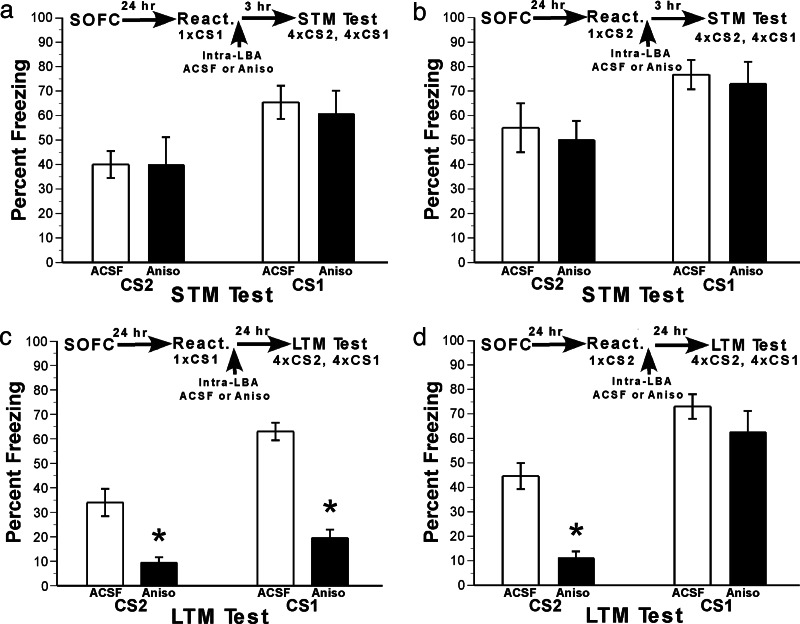Fig. 3.
The effects of protein synthesis inhibition in the LBA on postreactivation LTM depend on whether reactivation involved CS1 or CS2. Rats underwent SOFC and then were exposed to either CS1 or CS2, followed immediately by intraLBA infusion of ANISO or aCSF. Three hours later, postreactivation STM was tested. A separate group of rats underwent the same procedure, except that postreactivation LTM was tested. The two sets of data were analyzed with separate three-factor ANOVAs, with reactivation CS (CS1, CS2), drug (aCSF, ANISO), and retention test CS (CS1, CS2) as the factors (the retention test CS was a repeated-measures factor). (a and b) Protein synthesis inhibition in the LBA has no effect on postreactivation STM. Rats that received ANISO or aCSF infusions after exposure to CS1 (a) or CS2 (b) showed comparable levels of freezing to both CS1 and CS2 during the postreactivation STM test. The main effect of neither reactivation CS (P = 0.13) nor drug (P = 0.67) nor the interaction (P ≥ 0.7) was significant. There was a main effect of retention test CS [F (1, 24) = 45.7; P < 0.00001], indicating overall higher freezing to CS1 than CS2, which is commonly observed in studies of second-order conditioning (24–29). (c and d) Protein synthesis inhibition in LBA affects postreactivation LTM but in different ways, depending on which stimulus was reactivated. In contrast to the postreactivation STM test (a and b), in the postreactivation LTM test (c and d), there was a significant drug × reactivation CS × retention test CS interaction [F (1, 25) = 16.5; P < 0.001], indicating that the pattern of ANISO effects on fear memory for CS1 and CS2 depended on whether the reactivation stimulus was CS1 (c) or CS2 (d). The first-order interaction between drug and retention test CS was significant for CS1 reactivation [F (1, 13) = 9.0, P < 0.05] and for CS2 reactivation [F (1, 12) = 7.65; P < 0.05]. Post-hoc Tukey’s honest significant difference test mean comparisons revealed that after reactivation with CS1, ANISO had a significant effect on responses in the postreactivation LTM test elicited by CS2 (P < 0.001) and CS1 (P < 0.045), but after reactivation with CS2, ANISO affected responses elicited by CS2 (P < 0.05) and not CS1 (P = 0.71). These findings indicate that for the first-order associative memory (CS1–US) to undergo protein synthesis-dependent reconsolidation, it must be directly reactivated by CS1. Indirect reactivation of the first-order association by CS2 via the CS2 → CS1 → US associative network, fails to induce reconsolidation.

